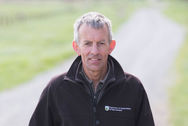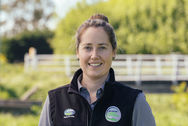-0-1200-0-0.jpg?k=1db98d86d2)
Can DOC and Fonterra really work together? Q&A with Robin & Libby
17 July 2018
Historically not the closest of allies, Fonterra and the Department of Conservation (DOC) are now in the midst of this 10-year partnership - Living Water, to trial ways to accelerate sustainable dairying and improve freshwater ecosystem health in five catchments.
How does this work out on the ground?
Here's the perspective of a pair who now work closely together: DOC’s Robin Smith and Fonterra Sustainable Dairying Advisor Libby Sutherland. They are trying out Living Water solutions in the Ararira/LII subcatchment of Canterbury’s Te Waihora/Lake Ellesmere.
1. What is a project you're working on?
Robin: We’re working on an ephemeral spring-fed waterway on Fonterra farmer David Irvine’s dairy farm in the head of the Ararira/LII River catchment in Springston, Canterbury. We’re aiming to protect spring-heads by managing critical areas where sediment, nutrients and contaminants can enter the waterway. We’ll also densely plant shallow sections of the waterway with aquatic plants to slow the flow, and enable denitrification which will reduce nitrates in the water.
2. How did you figure out a solution with landowners?
Libby: I was doing a Farm Environment Plan for the farm owned by David Irvine who is passionate about leading the way on farm environmental standards. Waterways are always a great opportunity to really make a difference to dairying’s sustainability, and obviously Living Water is interested in trialling different tools – so we met with David and our Living Water sustainable dairying manager Matt Highway onsite and decided on the simple solution: wide riparian margins to buffer the waterway and substantial planting.
3. What do you each contribute to the project?
Robin: I provide the “executional” side of the project: organising and overseeing the works, monitoring, engaging contractors etc. And thanks to Libby’s ongoing Sustainable Dairying Advisor relationship with the farmer – which carries on regarding business-as-usual farm activities too – we can openly discuss viable Living Water solutions with David Irvine and manager Harley Sutton.
4. What is most satisfying for you about this project?
Robin: I love working with willing motivated farmers who want to see some sort of freshwater improvement in New Zealand – it’s the beginning of a change among New Zealanders that can hopefully go beyond the freshwater environment too. It’s really quite pleasurable to talk with those motivated farmers, it gives you hope for the future. I know that at some stage New Zealand will attain a good balance around sustainability.
5. How does working together help?
Libby: We have the best of both worlds, being from very different organisations that both steward the land in different ways. Working together means that we’re able to combine our knowledge of farm systems, best practice and waterway and riparian management to get the best outcome for the farmer and the freshwater environment.
6. What have you learnt from each other?
Robin: We’ve learnt a lot about why this partnership is successful – it’s because of the strengths we bring from our respective organisations: an understanding of farming business, and the environmental knowledge and technical expertise DOC can offer.
In terms of the little things, one example is Libby has given me an understanding of the farm cycle – knowing when farmers and busy or not busy and the way farming works makes all the difference in working with the industry. On the other hand, with my background I might notice and point out interesting wildlife or flora in streams that gives Libby an insight into what we have on the farm that’s precious. There’s plenty of great stuff to learn when you’re from such different worlds – which may not be so different from each other in future.

Robin Smith

Libby Sutherland
-0-188-0-0.jpg?k=17f5eaee75)